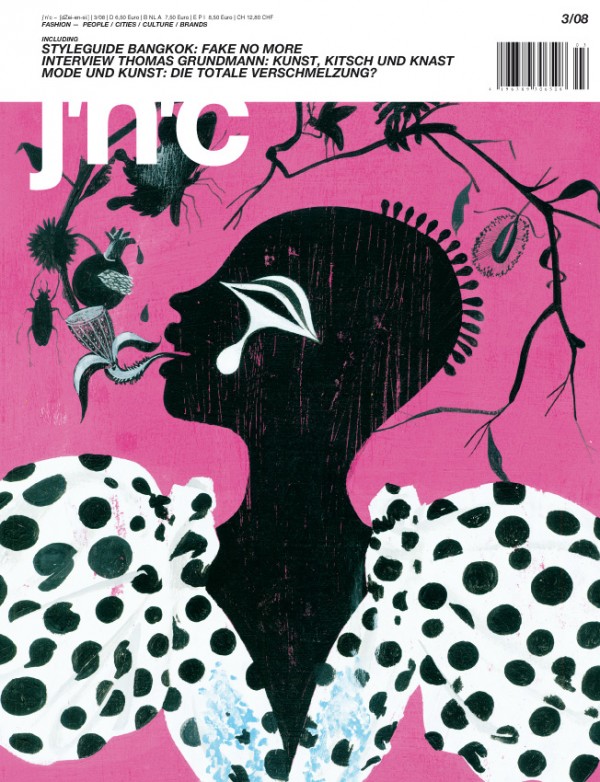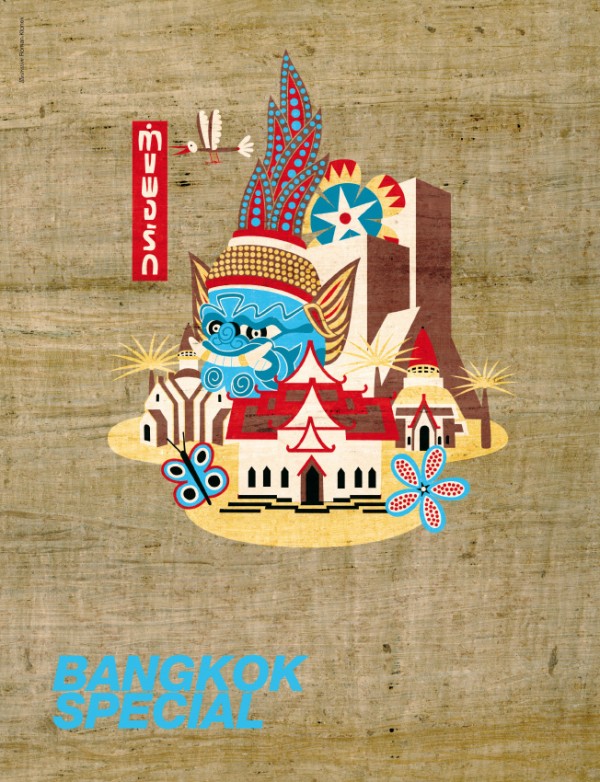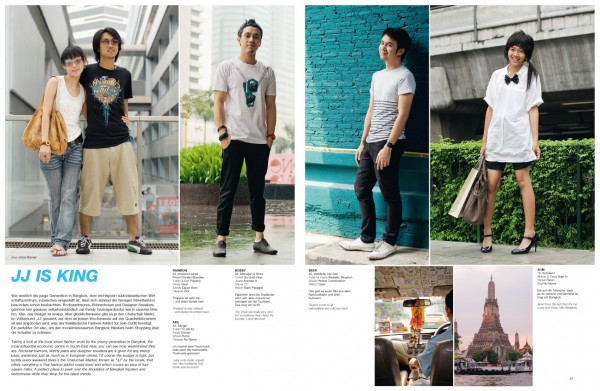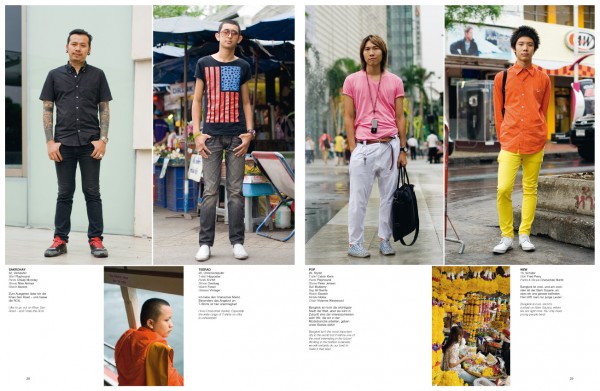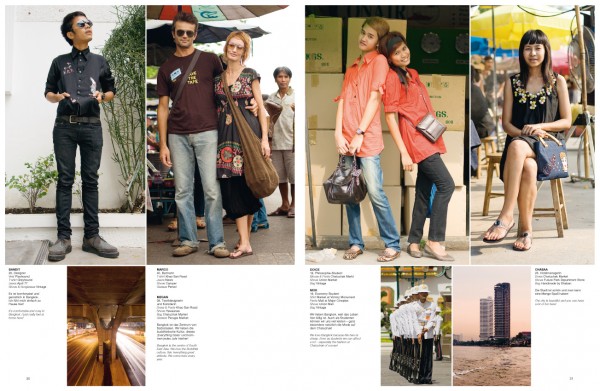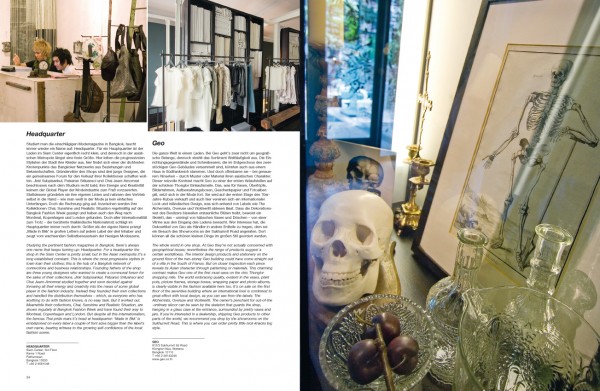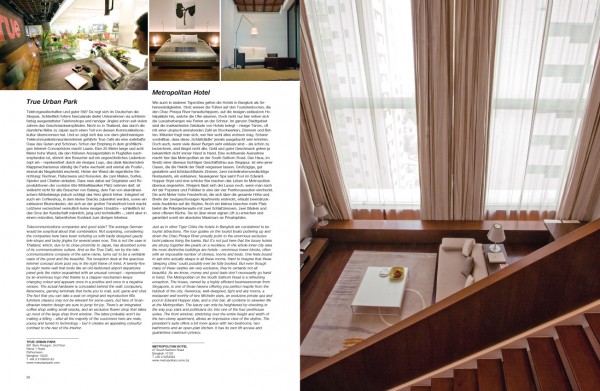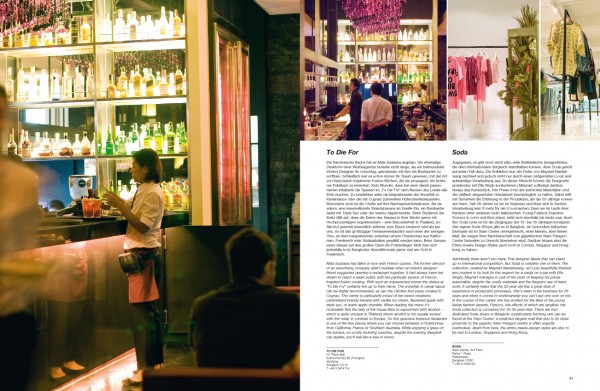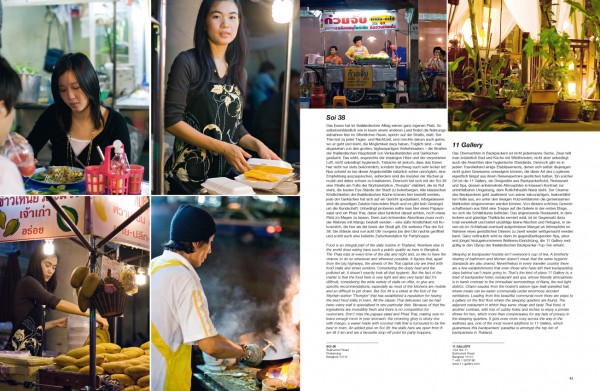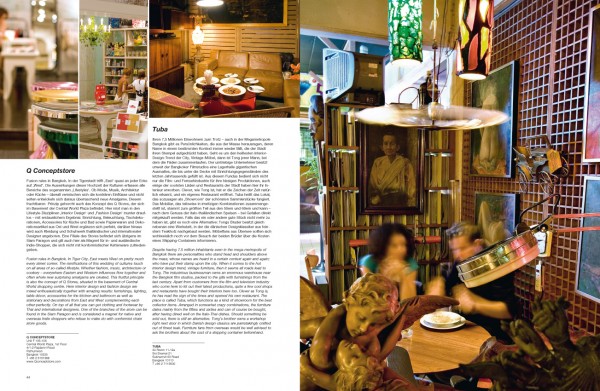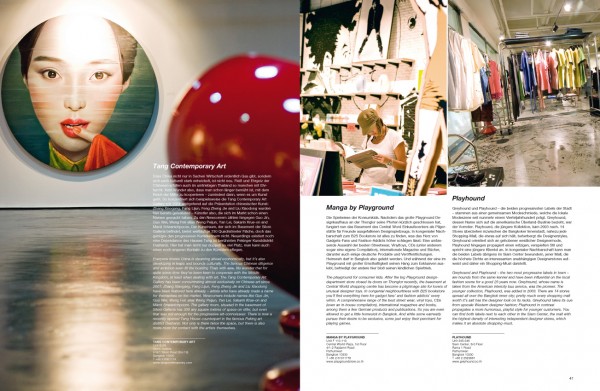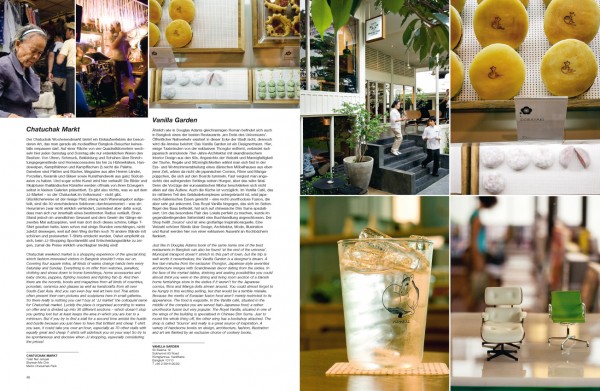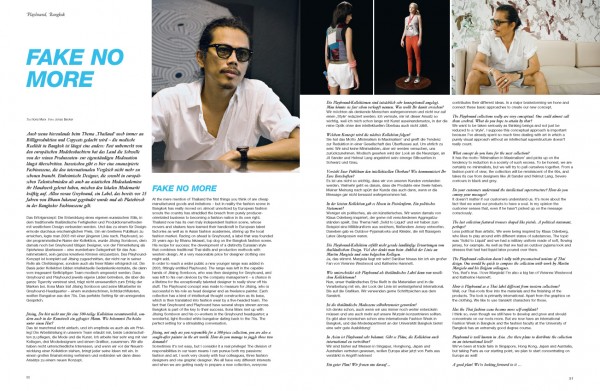Ilona Marx
Editorial work / Concepts / Texts
Cool Cities – Bangkok
Fashion / Retail / Travel
Teenage Love
My goodness, isn’t she young! That’s a comment that for once isn’t aimed at one of the go-go girls in the red light district but at its hometown, Bangkok. The metropolis with a population of 7.5 million is a mere 225 years old. No wonder that the city has had to deal with problems similar to that of a pubescent teenager: with rapid growth for example, causing an enormous building boom in the 80s and 90s of the last century. But financial problems, due to ineptitude and overconfidence, have also played a role, causing a short-term economic crisis in 1997.
In the meantime, they’ve learned by their mistakes. The new Metro and over ground Skytrains have alleviated the traffic congestion, a side effect of the growth spurt. And in the face of the towering, skeletal unfinished skyscrapers, pointing skyward like memorials to the economic crash, speculation and risk-taking has gone down too. The fact is Bangkok has grown up. This is partly thanks to the influence of a large number of academics who’ve returned home full of enthusiasm and rich in cosmopolitan experiences after studying on foreign soil. The image of an untidy third-world city is something Bangkok has left long behind. Multinational corporations have declared the market stable and are investing more and more in the local economy. All of this means that the burgeoning metropolis is now in the same category as Hong Kong and Singapore.
For those who arrive here for the first time, the city appears to be endless. There are multiple centres and the distances are quite substantial. The best orientation is the Chao Phraya River that flows once entirely through the city, and constitutes a valuable traffic artery, because it is airy and uncongested. Travelling by water taxi you can see popular tourist attractions like the Grand Palace and several magnificent temples like the Wat Mahathat or the Wat Arun, and the tourist district Banglamphu to which the legendary backpacker neighbourhood Khao San Road belongs, is also within easy access from the river. Not far away from there is Chinatown and the lively Indian quarter, one of those neighbourhoods where business and chaos aren’t irreconcilable, but on the contrary, seem almost to necessitate one another.
The new Bangkok, in contrast, can be discovered best by Skytrain. Starting at the Saphan Taxin Pier where the water taxis moor, the airconditioned and highly efficient train leads into the centre of the skyscrapers. At Siam Square a universe of enormous shopping centres unfolds, competing for the title of biggest and best. The World Trade Center, Gaysorn Plaza and Siam Paragon are among the top three, but even these, no doubt, will soon be challenged by newer marvels. A similar competitive spirit resides in the Silom Road, the diplomatic quarter where a lot of Farangs – the name for ‘long noses’ in Thai slang – live. But here it’s the luxury hotels that are vying for custom. Because of the high competition the prices are relatively humane. 130 sqm of penthouse suite costs a ‘mere’ 800 US dollars a night.
But a retreat into this kind of luxury haven isn’t the only option if you want to escape the hubbub of the streets for a while. Countless spas and massage salons offer peace and quiet and relaxation for just a few Baht for the city dweller stressed by air pollution and the tropical climate. But apart from the comforts that will sweeten your stay here in such a service-orientated city, the friendliness of the city dwellers, their culture, their cuisine, are more than enough reason to fall in love on the spot with this young, aspiring city. That’s certainly what happened to Ilona Marx, on her tour of discovery through the ‘tiger city’ with Jonas Becker, photographer and resident of Bangkok. For j’n’c she went in search of the prettiest markets, the best food stalls and the hottest newcomers on the fashion scene.
Thanks to Anke Lokietz and Pascal Nufer!
Selected texts from the City Guide
Thann Spa
Massage is part of Thai culture the way the Oktoberfest is part of German culture. Especially in tourist areas, visitors are rarely further than five metres away from the next massage bench. This is a situation that has lead to some quirky business ideas, because especially in rural areas several services are often combined. Whether you step into a travel agency, an internet café or even go to the local supermarket: the kneading hands are seldom far away. Yet massage isn’t simply massage; that much is clear on entry into the exclusive Thann spa. Thann has made a name for itself worldwide as producer of exclusive body care products; and just recently, adjacent to the large own store on the 4th floor of the trendy Siam Paragon Mall, the first massage spa has been opened. Admittedly the price for a session here is several times more expensive than at other establishments. So a 90-minute signature treatment with foot washing, accupressure massage, warm sesame compress and a delicious herb cordial costs around 56 Euros. But for that price you get to relax in the ultra stylish cabins and are worked on by absolute top professionals. The results are amazing: after a brief, initially not quite pain-free neck massage the aches and pains of a long day on the streets of Bangkok disappear as if by magic. Relieved and relaxed, the next logical step is to pop over to the shop next door to get a years’ supply of the fragrant miracle cures on offer from the Thann cosmetic series.
Mango Tango
The ‘Top Three’ of Thai tropical fruits? No question: pineapple, banana and mango. The latter is something akin to a national dish, and if you’ve ever had the pleasure of sinking your teeth into the sweet fruits here, you’ll no longer be satisfied by the stringy unripe cousins that go by the same name on our supermarket shelves. The exotic stone fruit is particularly delicious at harvest time, between March and May. And that’s when the business at Mango Tango really comes into its own. It’s a mini food chain with four shops in Bangkok and a branch in Tokyo, with the enchantingly simple concept of offering sweets and drinks made with mango. Whether mango pudding, mango-aloha, mango sticky rice, mango-Thai sundae or mango ice cream, everything that is on the menu here is sweet and delicious. The strictness of the menu is mirrored in the interior design. Lampshades are small baskets that were originally used during the mango harvest, and the whitewashed walls have been painted with the life story of a mango by the light-handed brushstrokes of artist Pongsakorn. That was the idea of creative interior designer Miss Mallikomas, who wants to continue the process: in regular intervals the wall will be freshly whitewashed to make room for other illustrators to paint their interpretations of the life of a mango.
Metropolitan Hotel
Just as in other Tiger Cities the hotels in Bangkok are considered to be tourist attractions. The tour guides on the tourist boats puttering up and down the Chao Phraya River proudly point to the enormous exclusive hotel palaces lining the banks. But it’s not just here that the luxury hotels are strung together like pearls on a necklace. In the whole inner-city area the most distinctive buildings are hotels – enormous tower blocks, often with an impossible number of storeys, rooms and beds. One feels bound to ask who actually sleeps in all these rooms. Hard to imagine that these ‘sleeping cities’ could possibly ever be fully booked. But even though many of these castles are very exclusive, they’re certainly not all beautiful. As we know, money and good taste don’t necessarily go hand in hand. The Metropolitan on the South Sathorn Road is a refreshing exception. The house, owned by a highly efficient businesswoman from Singapore, is one of those havens offering you perfect respite from the hubbub of the city. Generous, well-designed, light and airy rooms, a restaurant well worthy of two Michelin stars, an exclusive private spa and pool in Edward Hopper style, and a chic bar, all combine to sweeten life at the Metropolitan. The luxury can only be heightened by checking-in the way pop stars and politicians do: into one of the four penthouse suites. The front window, stretching over the entire height and width of the two-storey apartment, allows an impressive view of the skyline. The president’s suite offers a bit more space with two bedrooms, two bathrooms and an open-plan kitchen. It has its own lift access and guarantees maximum privacy.
Soi 38
Food is an integral part of the daily routine in Thailand. Nowhere else in the world does eating have such a public quality as here in Bangkok. The Thais eats at every time of the day and night and, so like to have the chance to do so whenever and wherever possible. It figures that, apart from the big highways, the streets of the Thai capital city are lined with food stalls and street vendors. Considering the dusty heat and the polluted air, it doesn’t exactly look all that hygienic. But the fact of the matter is that the food here is very light and also very tasty! But it’s difficult, considering the wide variety of stalls on offer, to give any specific recommendations, especially as most of the kitchens are mobile and so difficult to pin down. But Soi 38 is a street at the foot of the Skytrain station ‘Thonglor’ that has established a reputation for having the best food stalls in town. All the classic Thai delicacies can be had here; every stall is specialised in one particular dish. Because of that the ingredients are incredibly fresh and there is no competition for customers. Don’t miss the papaya salad and Phad Thai, making sure to leave enough room in your stomach: the crowning glory is sticky rice with mango, a sweet made with coconut milk that is rumoured to be the best in town. An added plus on Soi 38: the stalls here are open from 8am till 3am and are a favourite stop-off point for party-hoppers.
Gallery 11
Sleeping at backpacker hostels isn’t everyone’s cup of tea. A brotherly sharing of bathroom and kitchen doesn’t mean that the same hygienic standards are also shared. Nevertheless in every traveller country there are a few establishments that even those who have left their backpacking days behind can’t resist going to. That’s the kind of place Gallery 11 is; a triad of backpacker hotel, restaurant and spa, whose friendly atmosphere is in harsh contrast to the immediate surroundings in Nana, the red-light district. Charm exudes from the hostel’s saloon-type teak-panelled hall, where meals can be eaten communally under enormous wooden ventilators. Leading from this beautiful communal room there are steps to a gallery on the first floor where the sleeping quarters are found. The adjacent restaurant in which they serve cheap and tasty Thai food, is another contrast, with lots of cubby holes and niches to enjoy a private dinner for two, which more than compensates for any lack of privacy in the sleeping quarters. It gets even more cosy across the way in the wellness spa, one of the most recent additions to Gallery 11, which guarantees this backpackers’ paradise is amongst the top ten of places to stay in Thailand.
Q Conceptstore
Fusion rules in Bangkok. In Tiger City, East meets West on pretty much every street corner. The ramifications of this wedding of cultures touch on all areas of so-called lifestyle. Whether fashion, music, architecture or cookery – everywhere Eastern and Western influences flow together and often whole new surprising amalgams are created. This fruitful principle is also the concept of Q Stores, situated in the basement of CentralWorld shopping centre. Here interior design and fashion design are mixed enthusiastically together with amazing results: furnishings, lighting, table décor, accessories for the kitchen and bathroom as well as stationary and decorations from East and West complementing each other perfectly. On top of all that you can get clothing and footwear by Thai and international designers. One of the branches of the store can be found in the Siam Paragon and is considered a magnet for native and overseas Indie shoppers who refuse to make do with conformist chain store goods.
Vanilla Garden
Just like in Huxley’s ‘Brave New World’ one of the best restaurants in Bangkok can also be found ‘at the end of the universe’. Municipal transport doesn’t stretch to this part of town, but the trip is well worth it nevertheless; the Vanilla Garden is a designer’s dream. A few taxi-minutes from the exclusive Thonglor, Japanese-style seventies architecture merges with Scandinavian decor dating from the sixties. In the face of the myriad tables, shelving and seating possibilities you could almost think you were in the dining and living room section of a Danish home furnishings store in the sixties if it weren’t for the Japanese comics, films and Manga dolls strewn around. You could almost forget to be hungry in this exciting setting, but that would be a terrible mistake. Because the merits of Eurasian fusion food aren’t merely restricted to its appearance. The food is exquisite. In the Vanilla café, situated in the middle of the complex you are served Italo-Japanese food; a rather unorthodox fusion but very popular. The Royal Vanilla, situated in one of the wings of the building is specialised in Chinese Dim Sums. Just to round the whole thing off, the other wing has a bookshop attached. The shop is called ‘Source’ and really is a great source of inspiration. A variety of handsome books on design, architecture, fashion, illustration and art are flanked by an exclusive choice of cookery books.
J’N’C Magazine
Issue 03/2008
